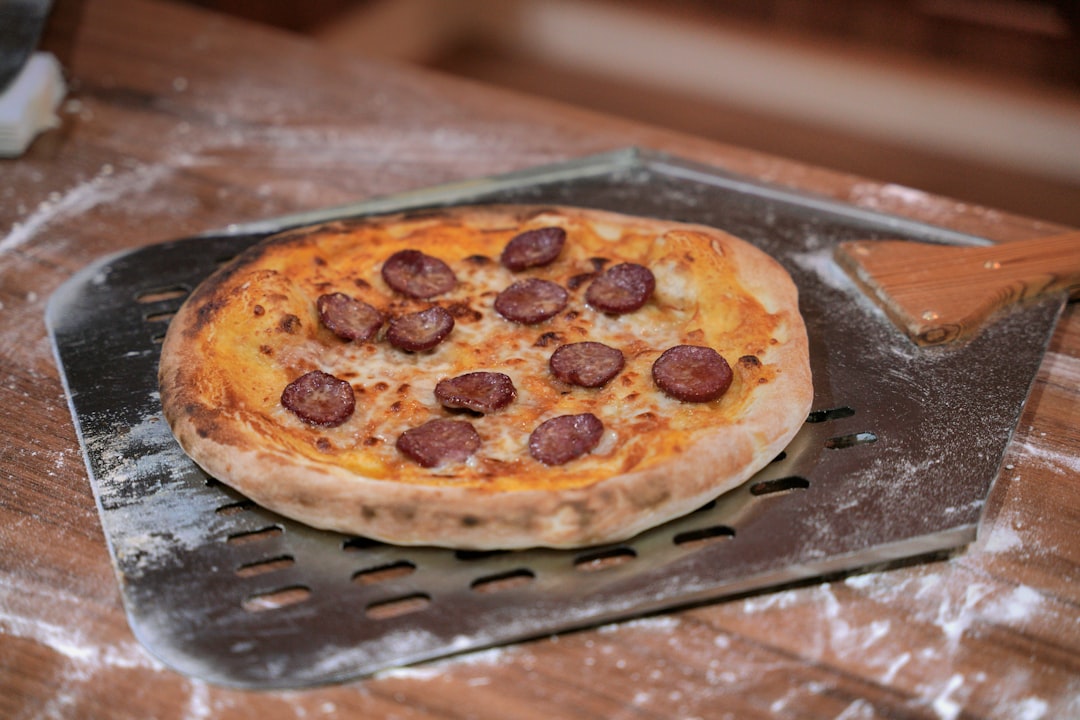
Unlock the Secrets of Your Aluminium Pizza Pan for the Ultimate Homemade Pie
Share
Why Your Aluminium Pizza Pan Could Be Your Kitchen's Best-Kept Secret
An aluminium pizza pan offers several key advantages that make it an excellent choice for both home and commercial pizza making:
Key Benefits:
- Excellent thermal conductivity - distributes heat quickly and uniformly
- Lightweight design - easier to handle than steel or cast iron
- Corrosion resistant - high resistance to rust and wear
- Versatile applications - perfect for pizza, focaccia, and appetizers
- Affordable pricing - typically ranges from $4-$25
- Even cooking results - promotes uniform baking without hot spots
While many pizza makers focus on heavier stones and steels, aluminium pans deliver consistent results with less fuss. Unlike alternatives that require long preheating, these pans heat up gradually with your pizza, creating a softer, more tender crust perfect for styles like Sicilian or focaccia. Aluminium's superior heat conduction (225W/°K) ensures your pizza bakes evenly from edge to center.
The trade-off? A softer crust, less crispy than what you'd achieve with other methods. But for many pizza styles and commercial operations, this gentler baking approach is ideal.
My experience in restaurant equipment sales has shown me how the right aluminium pizza pan can transform a kitchen's efficiency. These versatile tools deliver consistent results across every type of operation, from small pizzerias to large chains.
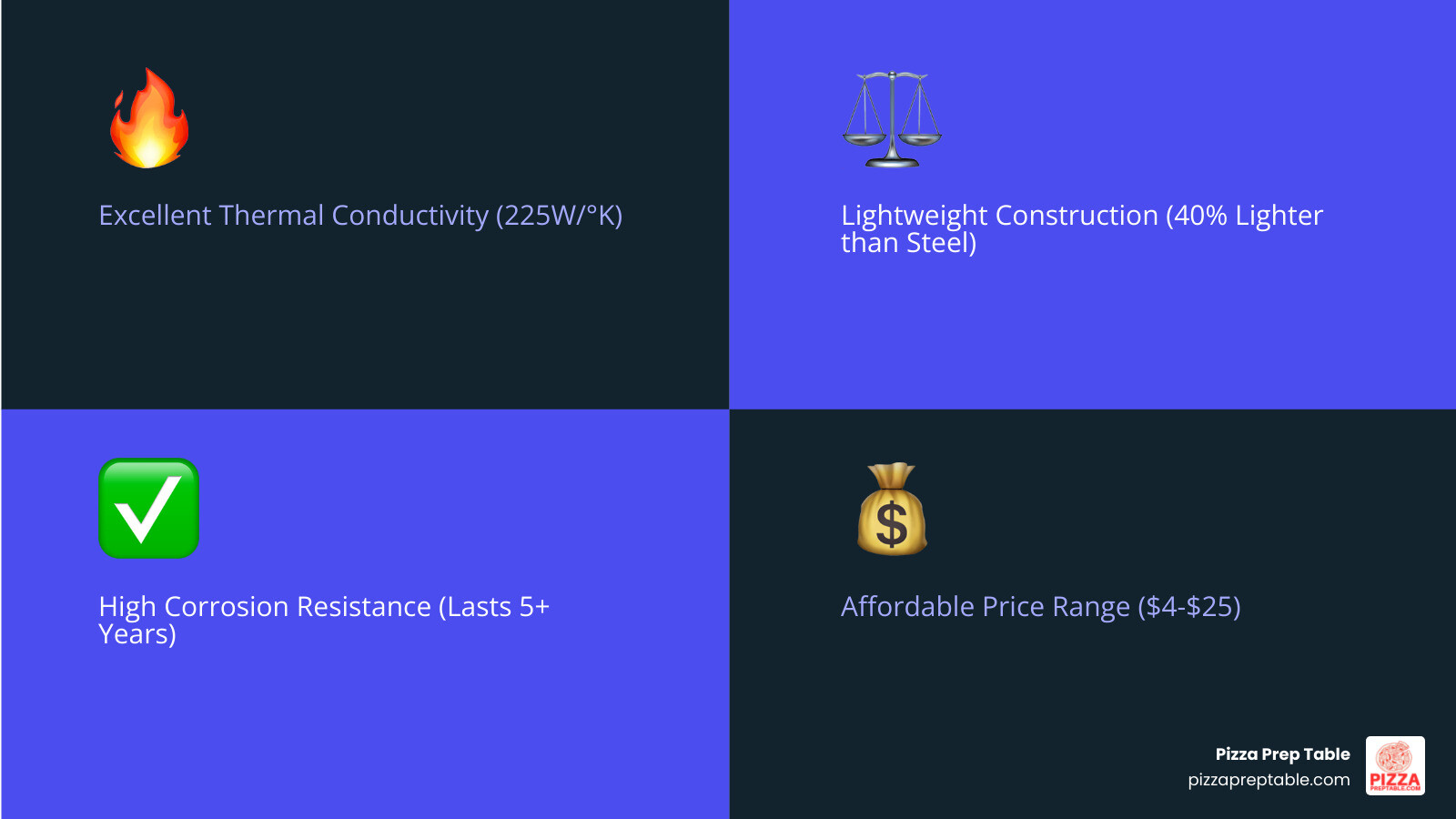
Why Choose Aluminum? The Surprising Advantages
While often overlooked, aluminium pizza pans are a staple in commercial kitchens for good reason. These workhorses deliver impressive benefits that might just surprise you.
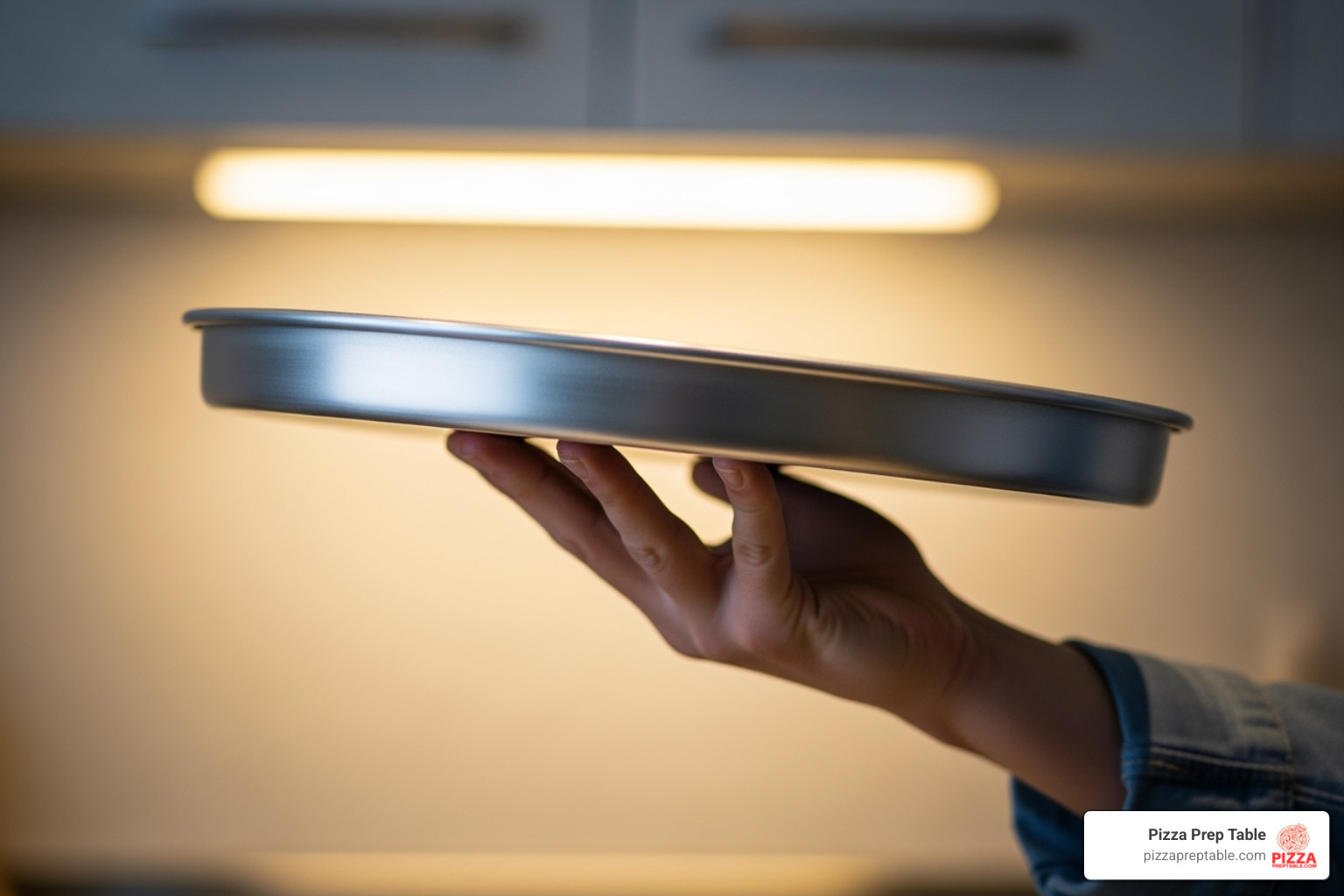
The heat conduction is where aluminum shines. The metal's excellent thermal conductivity spreads heat evenly across the entire pizza, eliminating frustrating cold spots or burnt edges. This ability to provide uniform cooking means you get predictable results every time, with a beautiful golden crust from edge to center.
Then there's the lighter weight. When you're pulling hot pans from a 500 F oven, especially during a dinner rush, every ounce counts. The durability is another winner; a quality aluminium pizza pan can handle the daily grind of commercial use, going from freezer to oven hundreds of times without warping.
Aluminum's versatility extends beyond pizza. These pans are perfect for softer crust styles and are absolutely ideal for focaccia bread, as the gentle, even heating creates a wonderfully tender texture.
For a complete setup, proper refrigeration is key. Check out our guide on Slice and Dice with Ease: 2-Door Pizza Prep Fridges Reviewed to see how the right equipment works together.
The Science of the Bake: Heat Transfer Explained
Understanding the science of an aluminium pizza pan helps you get better results.
Thermal conductivity is aluminum's superpower. It heats up gradually with your pizza, creating a gentler cooking environment. This means faster preheating for your oven setup, as you don't need to wait for the pan itself to reach temperature. The metal transfers heat efficiently from the oven to the dough for consistent results.
The even browning is particularly impressive, as heat distributes uniformly across the surface. This creates a softer vs. crunchy bottom compared to other materials. The gradual heating allows your dough to bake gently, developing a tender, chewy texture ideal for pan pizzas and Sicilian styles. The oven spring effect also benefits from this gentle heat, allowing the crust to rise properly without being shocked by intense heat.
For a quick primer on the concept, see this overview of thermal conductivity.
Beyond Pizza: Versatile Kitchen Uses
Aluminium pizza pans are the Swiss Army knife of the kitchen, handling multiple tasks with ease.
- Serving Tray: Go straight from oven to table, keeping pizza warm and reducing cleanup. This streamlines service in commercial settings.
- Appetizer Platters: The wide, flat surface is perfect for loaded nachos, breadsticks, or flatbreads, keeping them at serving temperature.
- Baking Cakes: These pans work beautifully for sheet cakes or coffee cakes that benefit from even heat.
- Roasting Vegetables: Effortlessly roast peppers, onions, and mushrooms for pizza toppings with uniform cooking.
- Focaccia Bread: Aluminum pans are practically made for focaccia, creating the perfect tender crumb and golden crust.
This versatility saves storage space and equipment costs. For more ways to optimize your kitchen, see our guide to Prep Like a Pizza Pro with These Topping Stations.
Choosing Your Perfect Aluminium Pizza Pan
So, you're convinced that an aluminium pizza pan is a must-have. Fantastic! Let's explore the nuances that will help you pick the perfect pan for your pizza-making adventures. Selecting the right pan can significantly impact your final creation.
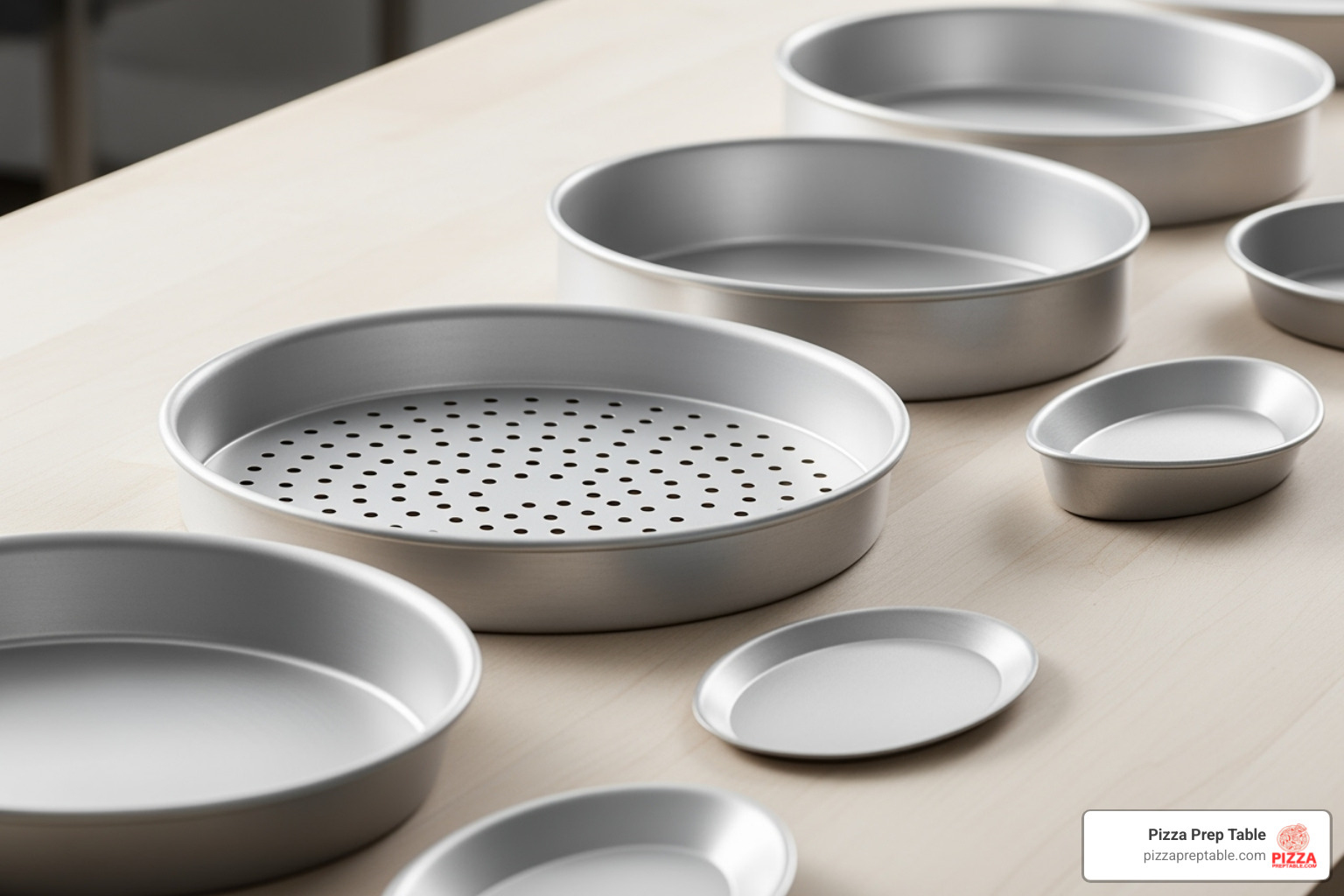
When I help customers select equipment, I always emphasize that "perfect" depends on your specific needs and the type of pizza you want to create. The good news? There's an aluminium pizza pan out there for every style and budget.
Key factors to consider include pan types, thickness (or gauge), rim types, and size and shape. The price range typically spans from $4 for basic home models to $25 for heavy-duty commercial versions.
Types of Pans for Every Pizza Style
The world of aluminium pizza pans is diverse, with each type designed for a specific outcome.
- Solid coupe pans are your classic workhorses. These flat, round pans with a slight rim work beautifully for soft, chewy crusts and are staples in most pizzerias.
- Perforated pans feature small holes to boost air circulation, allowing moisture to escape. This creates a crispier result, ideal for thin-crust pizzas.
- Deep-dish pans have higher sides perfect for Chicago-style pizzas, letting you pile on toppings without overflow.
- Wide rim pans have broader edges, making them easier to grip and transport safely. The rim also provides a stable base for serving.
- Straight-sided pans have vertical sides, creating uniform, sturdy crust edges that hold generous amounts of sauce and toppings. They excel in commercial settings for their precise crust formation.
When choosing, think about the pizza styles you love. Your answer will guide you to the perfect pan type.
Understanding Thickness and Gauge
This is where things get really interesting! The thickness and gauge of an aluminium pizza pan are critical factors that influence performance and durability. Gauge refers to the thickness of the metal – the lower the gauge number, the thicker the metal.
- 14 gauge aluminum is about 1.5mm thick and represents commercial-grade construction, offering superior performance.
- 18 gauge aluminum is thinner and lighter, making it great for occasional home use.
Warping resistance becomes crucial when you're working with high temperatures. Thicker pans maintain their shape beautifully in 500°F ovens, ensuring consistent contact with heat and a flat baking surface. Thin pans might buckle, leading to unevenly cooked pizza.
Durability improves dramatically with thickness. A robust gauge pan stands up better to frequent use and is less prone to dents and dings.
Heat retention benefits from the additional thermal mass in thicker pans. While aluminum conducts heat excellently regardless of thickness, a heavier pan holds onto heat more effectively. This creates a more stable baking environment and helps distribute heat consistently, preventing hot spots.
For heavy-duty use, I recommend opting for thicker gauges like 14 or 16. For occasional home use, an 18 gauge pan still performs admirably.
Mastering Your Pan: Prep, Baking, and Care
You've chosen your magnificent aluminium pizza pan – now what? Just like a well-loved cast iron skillet, an aluminum pan performs best when treated with a little TLC. Mastering its use, from the first bake to routine cleaning, will ensure you get consistently perfect pies and a pan that lasts for years.
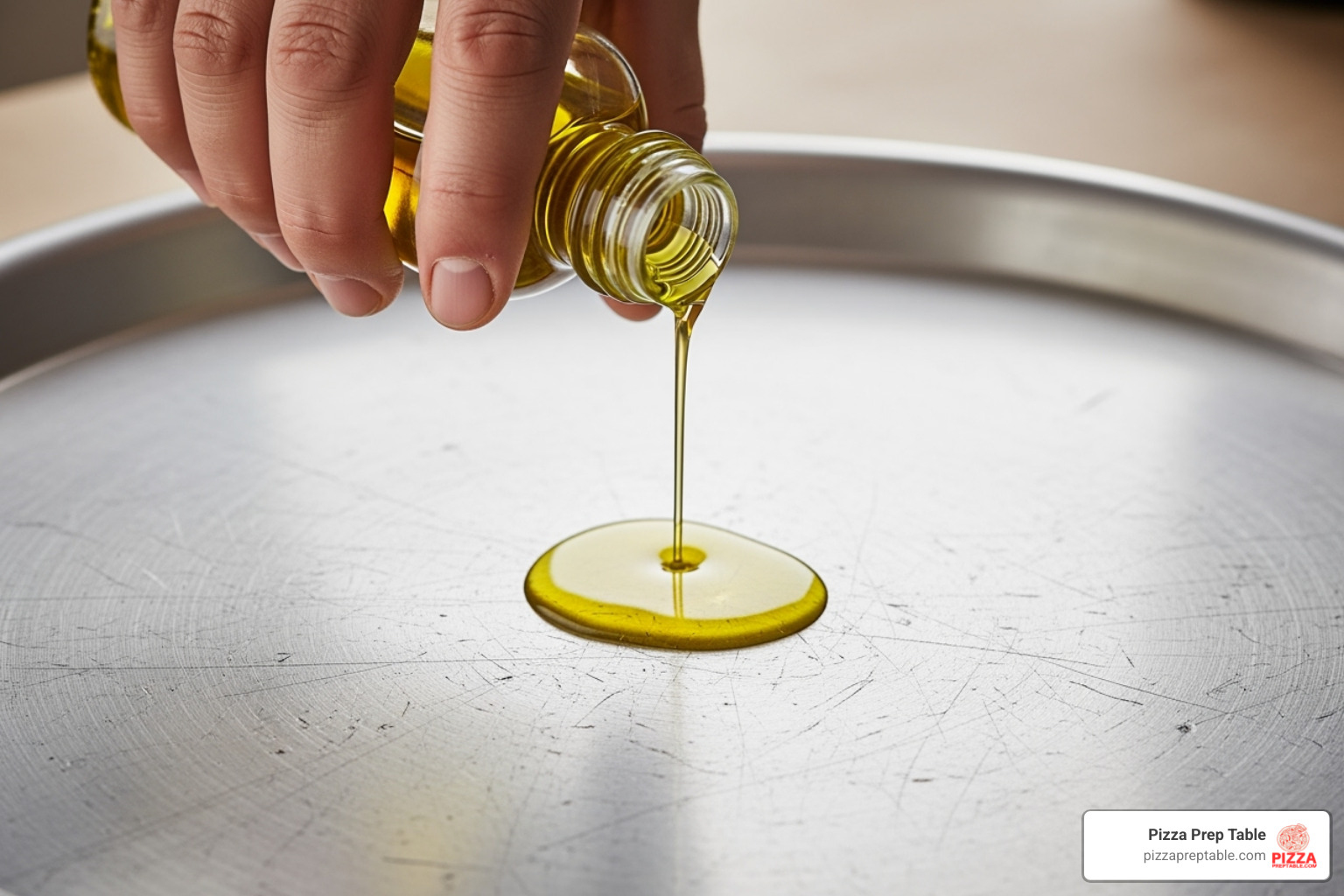
Proper care isn't just about making your equipment last; it's about optimizing its performance. Think of it as building a friendship with your pan – treat it well, and it'll reward you with countless perfect pizzas!
Pre-Bake Prep: To Season or Not to Season?
This is one of the most important steps. Most uncoated aluminum pans benefit greatly from seasoning, especially before their first use.
First, wash the new pan with warm, soapy water to remove any manufacturing residues. Rinse it well and dry it completely.
For the seasoning process, apply a thin layer of cooking oil (like vegetable oil) to the inside surface. You can let it sit for a few hours or, for better results, bake it in a 300-350°F oven for about an hour. Let it cool completely, and repeat once or twice.
Over time, your pan will likely develop a natural patina – a dark coating that is a sign of natural oxidation. This protective barrier improves the pan's non-stick properties and heat absorption, so don't scrub it off!
If you've invested in anodized versus uncoated aluminum, it has a hardened surface that is more durable and often doesn't need traditional seasoning. A good initial cleaning is still recommended. For more comprehensive pizza prep wisdom, check out our guide on how to prep pizza like a pro.
Baking for a Perfect Crust
Now for the exciting part – actually making pizza! The beauty of an aluminium pizza pan lies in its approach to heat. Here's the key: do not preheat your pan. It's designed to heat up gradually with your pizza. Preheating an empty aluminum pan can cause warping. Build your pizza on the room-temperature pan, then slide it into your preheated oven.
Because of this gradual heating, expect longer bake times – perhaps 14 minutes instead of 8. This isn't a flaw; it's a feature that develops a wonderfully soft, chewy texture. Most pans can handle oven temperatures up to 550°F.
A pro tip: dark-colored or anodized pans absorb more heat. Drop your oven temperature by 25°F and check your pizza about 10 minutes earlier, as they bake faster. To achieve a crisp bottom, ensure your oven is fully preheated. A perforated aluminium pizza pan also helps by improving air circulation.
Caring for Your Aluminium Pizza Pan for Longevity
Caring for your aluminium pizza pan is simple, but a few golden rules will keep it performing beautifully.
- Hand wash only. Dishwasher detergents are harsh on aluminum and can cause discoloration or pitting. Use warm, soapy water and a soft sponge.
- For stubborn baked-on food, let the pan soak in warm, soapy water, then use a plastic scraper or non-abrasive brush. Avoid steel wool.
- For proper storage, ensure the pan is completely dry and store it where it won't get scratched. Use paper towels between stacked pans.
- Accept the dark patina formation. This natural oxidation is a protective barrier that improves your pan's performance. Don't scrub it away!
Aluminum vs. Other Bakeware: What Sets It Apart?
When we talk about pizza, the baking surface is a hot topic. While there are many options out there, from heavy cast iron to porous ceramics, the aluminium pizza pan carves out its own unique niche. Let's break down how an aluminium pizza pan stacks up against other common bakeware materials.
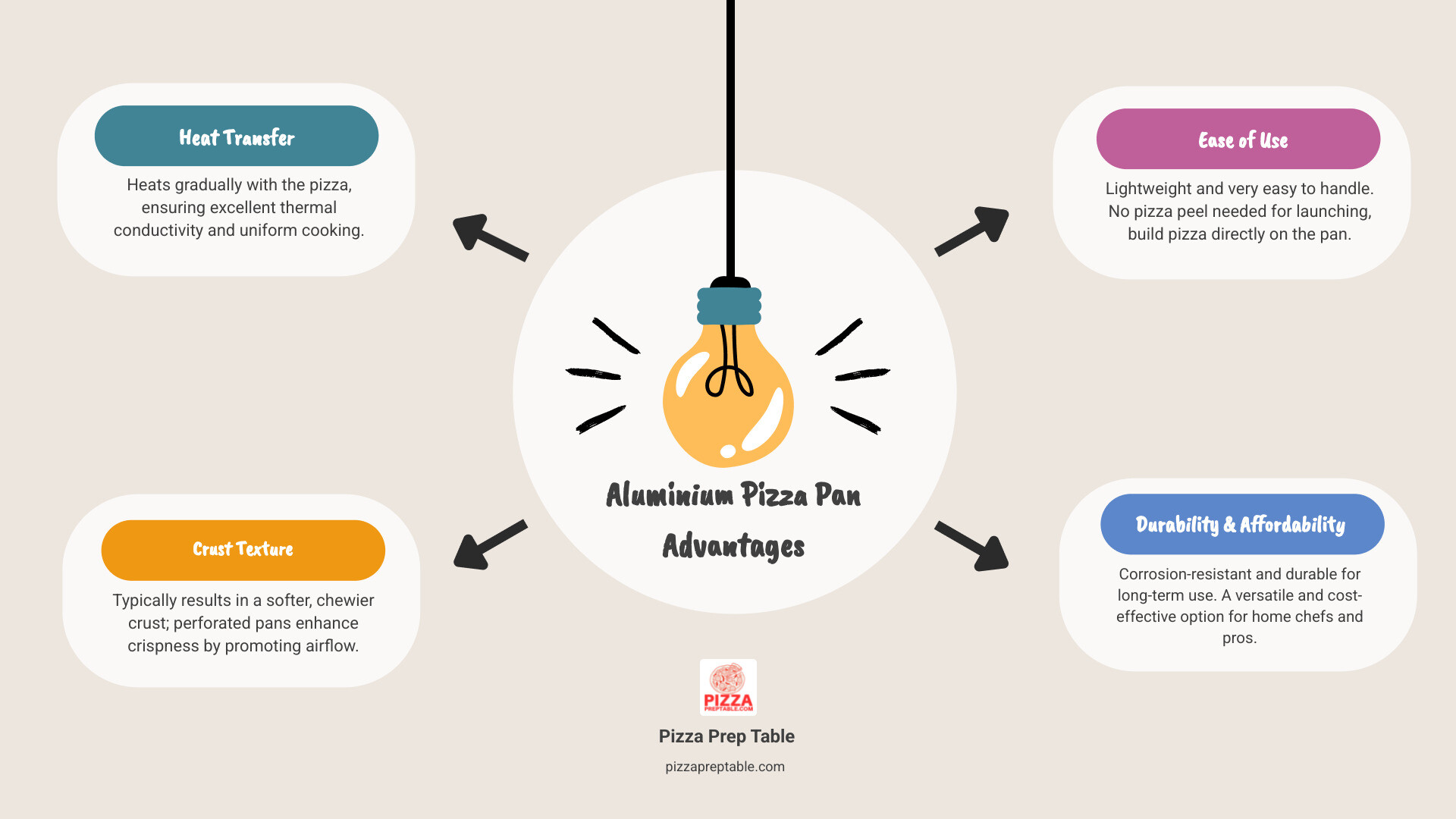
| Feature | Aluminium Pizza Pan | Other Bakeware (e.g., heavy steel, ceramic) |
|---|---|---|
| Heat-Up Time | Heats up gradually with the pizza, excellent conductivity. | Requires significant preheating (30-60+ min) to store and radiate heat. |
| Crust Crispiness | Tends to produce a softer, chewier crust; perforated pans offer more crispness. | Often creates a very crispy, crunchy, or charred crust. |
| Ease of Use | Very easy to handle, no pizza peel needed for launching. | Can be heavy, requires a pizza peel for launching, susceptible to thermal shock (ceramic). |
| Weight | Very lightweight, easy to maneuver. | Often very heavy and cumbersome. |
| Cost | Generally very affordable ($4-$25). | Can range from moderately expensive to very expensive. |
| Durability | Resistant to corrosion, lightweight, good lifespan with care. | Highly durable but can be brittle (ceramic) or rust (cast iron) if not maintained. |
| Maintenance | Hand wash only, may require initial seasoning. | Varies; some require seasoning, careful handling (ceramic), or specific cleaning to prevent rust. |
The biggest difference you'll notice is heat retention. Heavy materials store and blast heat into your dough, while aluminum's gentler approach creates a different crust texture - one that's tender and chewy rather than super crispy. This even cooking prevents a doughy interior while maintaining that beloved pan pizza texture. Plus, the ease of cleanup is a game-changer in high-volume settings.
The Great Crust Debate: Aluminum Pan and Your Pizza
The ideal crust is a matter of personal preference. If you prefer a softer, chewier base that can hold up to generous toppings, the aluminium pizza pan delivers beautifully.
This comes down to thermal mass and how aluminum conducts heat. Its gradual heating gives your dough time to develop a soft, airy crumb, resulting in a softer crust result that's cooked through without being dry. This is perfect for thick Sicilian or loaded pan pizzas. The ease of assembly is another huge win. You build your pizza right on the pan. No peel needed makes the process less intimidating for beginners and more streamlined for pros.
When to Choose Aluminum for Your Pizza
An aluminium pizza pan shines in several key situations.
Choose aluminum if you love a softer, chewier crust. Its lightweight design is easy to handle, and its versatility for appetizers and baked goods saves space and money. Affordability is another major advantage, offering exceptional value.
In commercial settings, restaurants choose aluminum for its consistency, efficiency, and how easy it is to handle and clean. It's a budget-friendly package that works beautifully for both home and commercial kitchens.
Frequently Asked Questions about Aluminium Pizza Pans
Over the years, we've had countless conversations with pizza makers who are curious about aluminium pizza pans. Here are the most common questions we hear.
Why did my pizza come out with a soft, doughy crust on an aluminum pan?
That soft, tender crust isn't a mistake—it's exactly what an aluminium pizza pan is designed to create. The pan heats up gradually with your dough, a gentler process that cooks the pizza through evenly. This develops the pillowy, chewy bite perfect for Detroit-style, Sicilian, or classic pan pizzas. For a crispier result, try a perforated pan or finish the pizza on a preheated stone for the last few minutes of baking.
Can I use metal utensils on my aluminum pizza pan?
This depends on the pan. For standard, uncoated aluminium pizza pans, it's best to use wooden or silicone utensils to avoid scratches. However, if you have a hard-coat anodized aluminum pan (these usually have a darker, more matte finish), its surface is incredibly tough and can handle metal utensils. When in doubt, check the manufacturer's recommendations.
Do I need to adjust my oven temperature when using a dark-colored aluminum pan?
Yes. Dark-colored aluminium pizza pans, especially anodized ones, are heat magnets. They absorb and radiate more heat, meaning your pizza will bake faster and develop a darker, crispier bottom. To prevent burning, we recommend you drop your oven temperature by about 25°F and check your pizza about 10 minutes earlier than the recipe suggests. This small tweak makes a big difference.
Conclusion
After exploring every aspect of the aluminium pizza pan, we hope you're as excited about this kitchen workhorse as we are! These unassuming pans pack a serious punch when it comes to creating consistently delicious pizzas with that perfect soft, chewy crust.
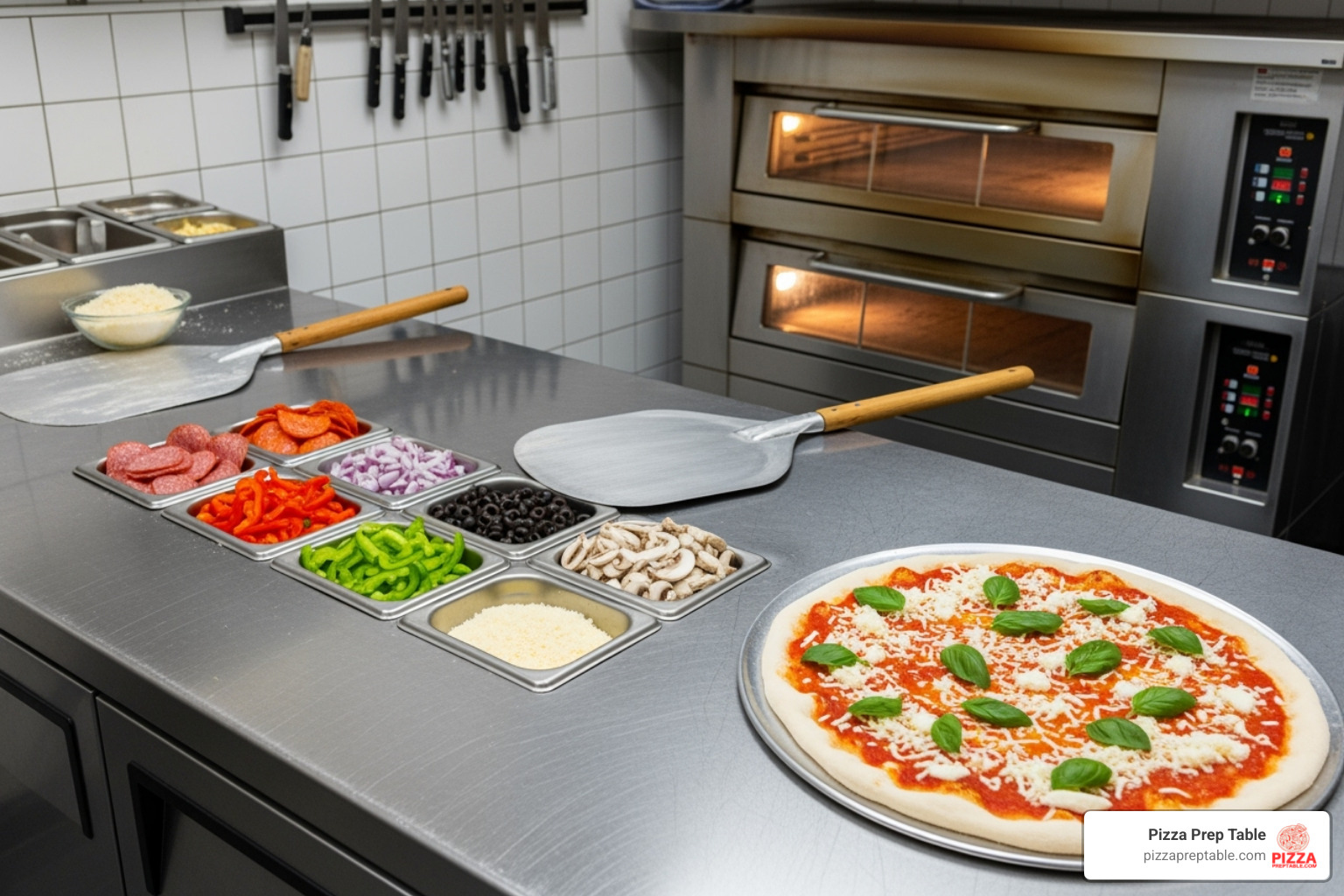
What makes the aluminium pizza pan truly special is the combination of excellent thermal conductivity, lightweight construction, and incredible versatility. Whether you're running a busy pizzeria or perfecting your pizza game at home, these pans deliver consistent results every single time.
The affordability factor can't be overlooked either. For just $4-$25, you're getting a tool that can transform your pizza-making experience. The gradual heating characteristic isn't a limitation – it's what gives you that tender, bread-like crust. And when you factor in the ease of use, it's easy to see why so many professional kitchens rely on aluminum pans.
At Pizza Prep Table, we've seen how the right equipment lifts every aspect of pizza making. While your aluminium pizza pan is a game-changer, creating a truly professional setup means thinking about the bigger picture.
Ready to take your pizza operation to the next level? Your aluminium pizza pan is just the beginning. For a complete guide to building out your pizza-making arsenal, check out our comprehensive resource on must-have commercial pizza oven supplies for perfect pies. Trust us – once you experience the difference that quality equipment makes, you'll never look back!
